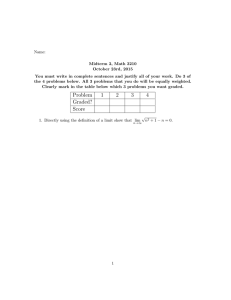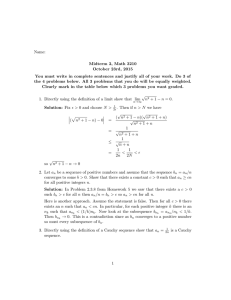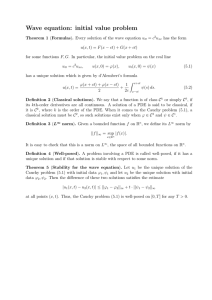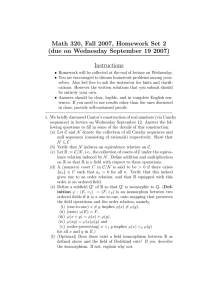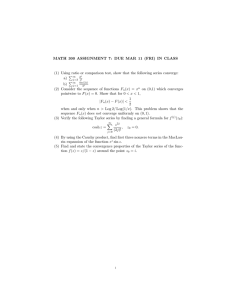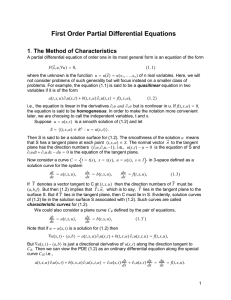Math 5440 Exam 1 Solutions
advertisement
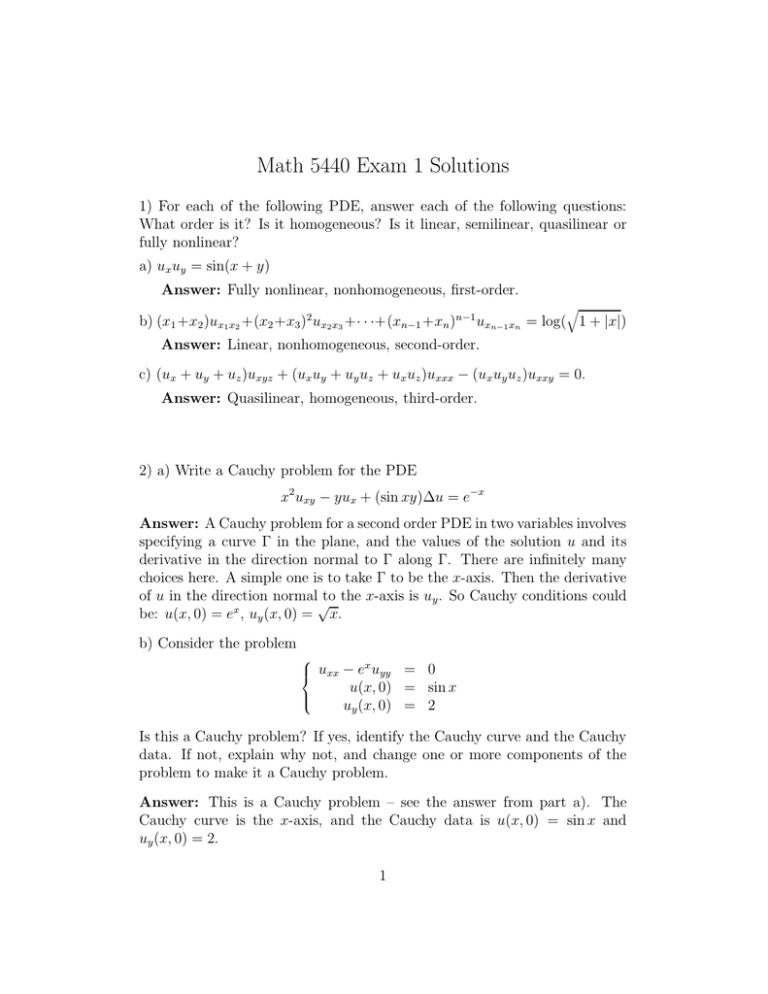
Math 5440 Exam 1 Solutions 1) For each of the following PDE, answer each of the following questions: What order is it? Is it homogeneous? Is it linear, semilinear, quasilinear or fully nonlinear? a) ux uy = sin(x + y) Answer: Fully nonlinear, nonhomogeneous, first-order. q b) (x1 +x2 )ux1 x2 +(x2 +x3 )2 ux2 x3 +· · ·+(xn−1 +xn )n−1 uxn−1 xn = log( 1 + |x|) Answer: Linear, nonhomogeneous, second-order. c) (ux + uy + uz )uxyz + (ux uy + uy uz + ux uz )uxxx − (ux uy uz )uxxy = 0. Answer: Quasilinear, homogeneous, third-order. 2) a) Write a Cauchy problem for the PDE x2 uxy − yux + (sin xy)∆u = e−x Answer: A Cauchy problem for a second order PDE in two variables involves specifying a curve Γ in the plane, and the values of the solution u and its derivative in the direction normal to Γ along Γ. There are infinitely many choices here. A simple one is to take Γ to be the x-axis. Then the derivative of u in the direction normal√to the x-axis is uy . So Cauchy conditions could be: u(x, 0) = ex , uy (x, 0) = x. b) Consider the problem uxx − ex uyy = 0 u(x, 0) = sin x uy (x, 0) = 2 Is this a Cauchy problem? If yes, identify the Cauchy curve and the Cauchy data. If not, explain why not, and change one or more components of the problem to make it a Cauchy problem. Answer: This is a Cauchy problem – see the answer from part a). The Cauchy curve is the x-axis, and the Cauchy data is u(x, 0) = sin x and uy (x, 0) = 2. 1 3) Consider the Cauchy problem ( a(x, y, u)ux + b(x, y, u)uy = 0 u(x, 0) = F (x) where F is continuously differentiable and F ′ (x) < 0 for all x. Suppose that the characteristic emanating from (ξ1 , 0) passes through the point (ξ2 , 0) and ξ1 6= ξ2 . Does this cause the problem to not have a solution? Why or why not? Answer: This problem cannot have a solution. The compatibility condition is du = 0. This implies that any solution would have to be constant dt along characteristics. So, along the characteristic emanating from (ξ1 , 0), a solution must be equal to F (ξ1 ). On the other hand, we are given that the characteristic emanating from (ξ1 , 0) passes through (ξ2 , 0), where a solution must have the value F (ξ2). Since F ′ (x) < 0, F (ξ1 ) 6= F (ξ2 ), so no solution can exist. 4) The PDE describing traffic flow on a stretch of one-way road with no cars entering between the two points x = 0 and x = 1, is ρt + ( ∂q )ρx = 0, ∂ρ where ρ(x, t) is the traffic density and q(x, t) is the traffic flux. Suppose that q = q(ρ) = −(ρ − 3)2 + 9, and that the initial traffic distribution is described (for 0 ≤ x ≤ 1) by ρ(x, 0) = −3x + 3 Find a formula for ρ(x, t) and verify that your result satisfies the PDE and the initial condition. Suppose that traffic cannot move if ρ becomes larger than 4; does this happen? Does the formula make sense for the problem for all time (for example are there any values of (x, t) for which ρ is negative?)? What happens to ρ as t → ∞? Is this result realistic? Why or why not? Answer: Since q(ρ) = −(ρ − 3)2 + 9, dq dρ = −2(ρ − 3). The PDE becomes ρt − 2(ρ − 3)ρx = 0. = 0, which implies that ρ is constant The compatibility condition is dρ dt on characteristics. On the characteristic emanating from (ξ, 0), ρ must be 2 equal to −3ξ + 3, from the initial condition. The characteristic ODE is dx = −2(ρ − 3). Therefore, the characteristic through (ξ, 0) is described by dt dx = −2(−3ξ + 3 − 3) = 6ξ. dt Therefore the characteristic through (ξ, 0) is x = 6ξt + ξ. Solving for ξ we x obtain ξ = 1+6t . Therefore, ρ(x, t) = −3( x ) + 3. 1 + 6t Since x ∈ [0, 1], the first term is between −3 and 0, for all (x, t) ∈ [0, 1] × [0, ∞). Therefore, ρ is never negative and never reaches the critical level of 4. As t → ∞, ρ → 3, since the first term goes to zero. This indicates that as time goes on, the density becomes uniform on this stretch of road. Also, since ρ approaches a constant, so does q, so this model predicts constant density and constant speed of travel as time increases. This is realistic given the constraints of the problem, but not from the perspective of actual traffic flow. For one thing, the model predicts that q(0, t) = 9 for all t, which implies a constant stream of cars entering this stretch of road. 3
